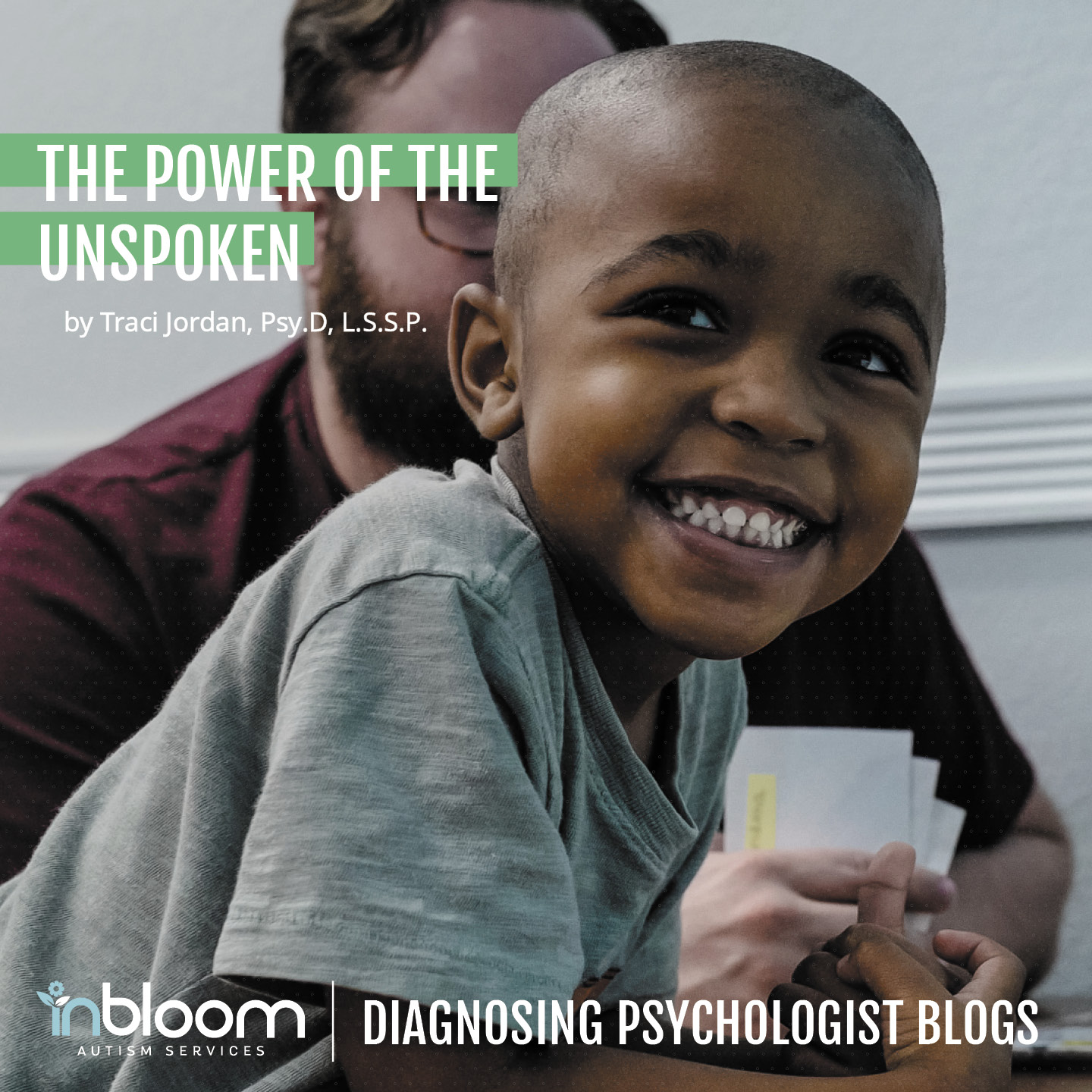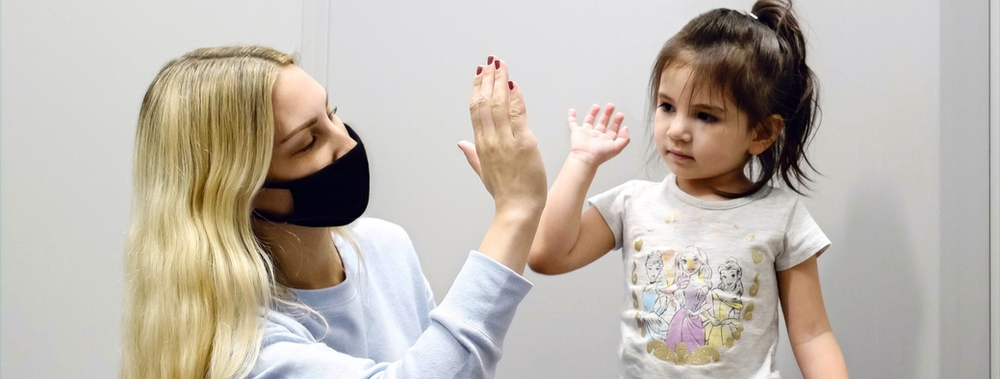The Power of the Unspoken

Human behavior is dynamic; we are always moving, posturing, and changing facial expressions. While engaging in constant movement we communicate a myriad of messages, in totality called nonverbal communication. Nonverbal communication includes non-speech qualities of voice. It also subsumes body language.
Psychologists describe body language as the language of feelings because we are not always consciously aware of the signals we give out through our body language. Thus we may disguise our feelings with our words while our true feelings may slip out, if only for a moment, through our body language.
With our body language we convey emotions such as trust and openness but also fear and anger. We may emphasize a spoken word, such as raising a fist upward to indicate, ‘yes.’ We may express caring by a loving touch or hug.
We can only imagine how confusing these signals can be to children on the spectrum who struggle with or avoid sustained eye contact.
Children on the spectrum tend to face difficulty looking directly at others to make eye contact and thus they may miss subtle changes in another’s body language necessary for formulating an appropriate response. It is challenging for all of us to accurately decipher non-verbal messages in voice and facial expression and to respond appropriately to these nonverbal messages. We can only imagine how confusing these signals can be to children on the spectrum who struggle with or avoid sustained eye contact. ABA therapy often supports children in developing skills to interpret such signals. And yet, the ability to interpret visual cues holds even more benefit for children on the spectrum because they are often visual learners.
All the more important when we consider the many ways that body language cues facilitate (or hinder) social communication. In a 2008 paper, The Importance of Effective Communication, Edward G. Wertheim distinguished between several of these nonverbal functions:
- Complement. Gestures, especially when repeated, may serve to enhance or strengthen our message, such as giving a high 5 when we congratulate children on a job well done.
- Substitution. Choosing body language over words is powerful in situations when words are just inadequate, such as when a child is experiencing strong emotions and not likely to process words. At times a caring hug or sympathetic look can convey our meaning far more effectively than mere words can express.
- Contradict. When our body language is at odds with our spoken words we may confuse the listener, for example, when we sigh deeply and close our eyes while verbalizing, “I’m not mad!” or shake our heads while verbalizing, “I’m so glad.”
In addition to mismatched nonverbal communication, psychologists consider cultural bound interpretations of gestures. Eye contact, defined as looking directly into another person’s eyes, may have different meanings depending on the child’s culture. While limited eye contact may indicate lack of confidence or lack of interest in Western culture, in many Asian, African and Latin American cultures, sporadic or brief eye contact is considered polite, even respectful. At times the interpretation of a gesture may be a matter of degree. Even in Western culture, for example, intense eye contact is reserved for situations involving familiarity.
No wonder children on the spectrum have difficulty understanding and responding to non-verbal cues. We all get confused at times! “Taken together, these difficulties affect the ability of children with ASD to interact with others, especially people their own age,” according to the National Institute of Deafness and Other Communication Disorders. It follows that helping children both interpret others’ nonverbal communication and express themselves nonverbally will help our children adapt socially and scholastically. As an added benefit, becoming experts in our child’s body language will help us interpret our child’s nonverbal behavior, and thus enhance our understanding of our child. By analyzing each channel of communication we can better facilitate mutual understanding:
In addition to mismatched nonverbal communication, psychologists consider cultural bound interpretations of gestures.
FACIAL EXPRESSIONS MIRROR OUR EMOTIONS
Reading another’s facial expressions accurately makes it more likely that a child with ASD will show an understanding of the other’s emotional state. We can start by teaching them that certain facial expressions, such as a smile, have universal meaning. To take advantage of your child’s visual skills, teach facial expressions by pairing the emotion with a picture of someone’s facial expression conveying the emotion. With an older child, set the pictures in front of the child and ask them to identify the emotion based on the facial expression. Or show the picture, name the emotion, and have the child imitate the facial expression. Consider starting with simple line drawings that emphasize the emotion, moving on to cartoon pictures with exaggerated emotional expressions, and finally, more nuanced human faces.
POSTURE & MOVEMENT
Leaning forward conveys interest. Turning our back on someone, literally, may be interpreted as disrespectful. The best way to teach children good posture is to model standing tall and to provide plenty of exercise for strengthening muscles. And like the commercial says, discover the joy of movement! Give your little ones opportunities to move about between tasks. Alternate tasks requiring them to sit with tasks involving expenditure of energy.
NEED FOR SPACE
Although lack of social interest is often a sign of ASD in young children, in other children you may see lack of interpersonal boundaries. Sometimes young children, including children on the spectrum, have to be taught to respect other’s needs for personal space.
EYE CONTACT
Looking directly into another’s eyes has a huge impact on social interaction. For children on the spectrum, it can be important to observe not just whether eye contact is present but how it is used and how it is coordinated with gestures and other channels of communication. Eye contact can be improved by calling your child’s name while holding an interesting object at eye level. However, do not force eye contact; research suggests that looking directly in another’s eye may be anxiety provoking for children on the spectrum, although their anxiety typically diminishes depending on the familiarity of the situation. No one looks toward another 100 percent of the time; there are so many situational and individual personality factors that influence the intensity of our eye contact. Besides, you may have noticed, often your child is listening to you even when they are not looking at you.
PARALIGUISTICS OR PARALANGUAGE
Paralinguistics, or paralanguage, compliments body language as the 2nd aspect of nonverbal behavior. Paralanguage refers to non-lexical (beyond words) components of speech such as pitch, tone, inflection, rhythm, intonation, volume, pauses, timbre, etc. You might remember grandma’s rule: “it isn’t what you say, it is how you say it.” Many ASD children have difficulty interpreting paralinguistics, including the meaning of vocal tones and pitch that change the meaning of the uttered words (National Institute of Deafness and Other Communication Disorders). Try Motherese, that is, slowing down your speech, lowering your volume, varying your pitch and intonation while enunciating clearly, and pausing between words. Keep the message short; less is more.
Importantly, tune into your child’s non-verbal language to help them feel understood.
COMMUNICATION OVERLAP
Even children sometimes give us mixed messages through different channels of communication. If your child’s nonverbal communication conflicts with their spoken words, consider the communication through both channels important. However, incongruence between nonverbal and verbal communication detracts from one’s message. It may, at times, be appropriate to point out the inconsistencies or discrepancies between their verbal and non-verbal communication. For example: “you said you feel fine, but your lips are turned down, telling a different story.”

Psychologists believe that relaxation helps both children and adults become more congruent in their communication. Therefore, teach your child relaxation strategies, such as petting the family dog, smelling a favorite scent, listening to music during transitions, or squeezing a sensory ball. Because nonverbal language taps into our emotional brain, giving children a sensory experience that will lower their stress level. Their more relaxed state will show in their body language.
Autism Speaks, a non-profit advocacy and research organization for families of children with autism spectrum disorder, recommends that we imitate our children’s sounds and behaviors to encourage socially directed vocalizations and body language. Model specific nonverbal behavior, such as tapping your feet and clapping your hands, and explain what feeling the behavior represents. Emphasize your body language; be dramatic!
Importantly, tune into your child’s non-verbal language to help them feel understood. Like many busy parents of young children, I often called out, “honey I’m listening,” while checking text messages or without taking my eye off my computer screen. Distractions are a part of our daily lives, but we can commit to eliminating them for 10 minutes a day by turning off electronics, including cell phones, and giving children our undivided physical attention. By improving how we interpret and respond to our children’s nonverbal cues, we can help them better understand, connect, and build more satisfying interpersonal relationships. Another one of my grandma’s adages: “draw on your excellent command of the English language by keeping quiet and listening:” Not just with our ears, but with our eyes and heart.
ABOUT THE AUTHOR

Traci Jordan, Psy.D., L.S.S.P. holds a dual license in clinical and school psychology, and has assessment experience with a wide range of developmental, cognitive, psychological problems and challenges. She has a lifelong passion for child development and family systems, completing pre and postdoctoral training in child clinical and developmental pediatrics before opening a private practice focused on child assessment and treatment. She draws on her 30 years of experience in assessment and research methods to develop and teach a core graduate level class in psychodiagnostics through the Department of Educational Counseling of Texas A&M Corpus Christi. A mother and tireless advocate for children and diversity in her personal life; She is proud of serving as a foster parent for 10 years and as a board member for Nueces County Court Appointed Special Advocates (CASA). Yoga, family, friends, and pets keep her centered.
REFERENCES
Dawson, G., & Elder, L. (2013). Teaching nonverbal children to speak. Autism Speaks
QianYing, Y, LinRu, L, ShaoLi, L, SanMei, C, HuiLin, Z, YanTing, X, XiaoBing, Z, & HongZhu, D. (January 2021). The gestures in 2-4 year-old children with autism spectrum disorder. Frong Psychology.
Yoshida, H., Cirino, P. Mire, S. S., Burling, J. M., & Lee, S. (2019). Parents’ gesture adaptations to children with autism spectrum disorder. Cambridge University Press: 07 October 2019: importance of mirroring.
Wertheim, E. G. (2008). The Importance of Effective Communication. North Eastern University, College of Business Administration. Retrieved 10/10/08 from http://web.cba.neu.edu/~ewertheim/interper/commun.htm7.


